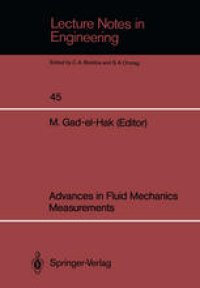
Ebook: Advances in Fluid Mechanics Measurements
- Tags: Fluid- and Aerodynamics, Engineering general, Mechanics, Thermodynamics, Renewable and Green Energy, Geoengineering Foundations Hydraulics
- Series: Lecture Notes in Engineering 45
- Year: 1989
- Publisher: Springer-Verlag Berlin Heidelberg
- Edition: 1
- Language: English
- pdf
One cannot overemphasize the importance of studying fluids in motion or at rest for a variety of scientific and engineering endeavors. Fluid mechanics as an art reaches back into antiquity, but its rational formulation is a relatively recent undertaking. Much of the physics of a particular flow situation can be understood by conducting appropriate experiments. Flow visualization techniques offer a useful tool to establish an overall picture of a flow field and to delineate broadly its salient features before embarking on more detailed quantitative measurements. Among the single-point measurements that are particularly difficult are those in separated flows, non-Newtonian fluids, rotating flows, and nuclear aerosols. Pressure, shear stress, vorticity, and heat transfer coefficient are also difficult quantities to measure, particularly for time-dependent flows. These and other special situations are among the topics covered in this volume. Each article emphasizes the development of a particular measuring technique. The topics covered were chosen because of their importance to the field, recent appeal, and potential for future development. The articles are comprehensive and coverage is pedagogical with a bias towards recent developments.
One cannot overemphasize the importance of studying fluids in motion or at rest for a variety of scientific and engineering endeavors. Fluid mechanics as an art reaches back into antiquity, but its rational formulation is a relatively recent undertaking. Much of the physics of a particular flow situation can be understood by conducting appropriate experiments. Flow visualization techniques offer a useful tool to establish an overall picture of a flow field and to delineate broadly its salient features before embarking on more detailed quantitative measurements. Among the single-point measurements that are particularly difficult are those in separated flows, non-Newtonian fluids, rotating flows, and nuclear aerosols. Pressure, shear stress, vorticity, and heat transfer coefficient are also difficult quantities to measure, particularly for time-dependent flows. These and other special situations are among the topics covered in this volume. Each article emphasizes the development of a particular measuring technique. The topics covered were chosen because of their importance to the field, recent appeal, and potential for future development. The articles are comprehensive and coverage is pedagogical with a bias towards recent developments.
One cannot overemphasize the importance of studying fluids in motion or at rest for a variety of scientific and engineering endeavors. Fluid mechanics as an art reaches back into antiquity, but its rational formulation is a relatively recent undertaking. Much of the physics of a particular flow situation can be understood by conducting appropriate experiments. Flow visualization techniques offer a useful tool to establish an overall picture of a flow field and to delineate broadly its salient features before embarking on more detailed quantitative measurements. Among the single-point measurements that are particularly difficult are those in separated flows, non-Newtonian fluids, rotating flows, and nuclear aerosols. Pressure, shear stress, vorticity, and heat transfer coefficient are also difficult quantities to measure, particularly for time-dependent flows. These and other special situations are among the topics covered in this volume. Each article emphasizes the development of a particular measuring technique. The topics covered were chosen because of their importance to the field, recent appeal, and potential for future development. The articles are comprehensive and coverage is pedagogical with a bias towards recent developments.
Content:
Front Matter....Pages N1-VII
Air Flow Visualizaton Using Titanium Tetrachloride....Pages 1-31
Three-Dimensional Quantitative Flow Diagnostics....Pages 33-107
Particle Tracing: Revisited....Pages 109-126
Particle Image Velocimetry....Pages 127-199
Dynamic Wall Pressure Measurements....Pages 201-227
The Measurement of Wall Shear Stress....Pages 229-261
The Measurement of Vorticity in Transitional and Fully Developed Turbulent Flows....Pages 263-321
Time-Resolved Heat Transfer and Skin Friction Measurements in Unsteady Flow....Pages 323-355
Scanning Laser Anemometry and Other Measurement Techniques for Separated Flows....Pages 357-400
Measurement Techniques in Laboratory Rotating Flows....Pages 401-534
Experiments in Drag-Reducing Polymer Flows....Pages 535-568
Nuclear Aerosol Measurement Techniques....Pages 569-600
Back Matter....Pages 601-602
One cannot overemphasize the importance of studying fluids in motion or at rest for a variety of scientific and engineering endeavors. Fluid mechanics as an art reaches back into antiquity, but its rational formulation is a relatively recent undertaking. Much of the physics of a particular flow situation can be understood by conducting appropriate experiments. Flow visualization techniques offer a useful tool to establish an overall picture of a flow field and to delineate broadly its salient features before embarking on more detailed quantitative measurements. Among the single-point measurements that are particularly difficult are those in separated flows, non-Newtonian fluids, rotating flows, and nuclear aerosols. Pressure, shear stress, vorticity, and heat transfer coefficient are also difficult quantities to measure, particularly for time-dependent flows. These and other special situations are among the topics covered in this volume. Each article emphasizes the development of a particular measuring technique. The topics covered were chosen because of their importance to the field, recent appeal, and potential for future development. The articles are comprehensive and coverage is pedagogical with a bias towards recent developments.
Content:
Front Matter....Pages N1-VII
Air Flow Visualizaton Using Titanium Tetrachloride....Pages 1-31
Three-Dimensional Quantitative Flow Diagnostics....Pages 33-107
Particle Tracing: Revisited....Pages 109-126
Particle Image Velocimetry....Pages 127-199
Dynamic Wall Pressure Measurements....Pages 201-227
The Measurement of Wall Shear Stress....Pages 229-261
The Measurement of Vorticity in Transitional and Fully Developed Turbulent Flows....Pages 263-321
Time-Resolved Heat Transfer and Skin Friction Measurements in Unsteady Flow....Pages 323-355
Scanning Laser Anemometry and Other Measurement Techniques for Separated Flows....Pages 357-400
Measurement Techniques in Laboratory Rotating Flows....Pages 401-534
Experiments in Drag-Reducing Polymer Flows....Pages 535-568
Nuclear Aerosol Measurement Techniques....Pages 569-600
Back Matter....Pages 601-602
....